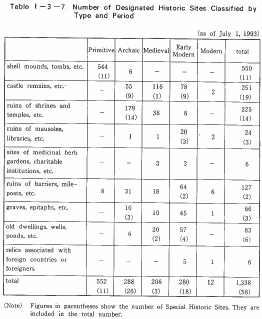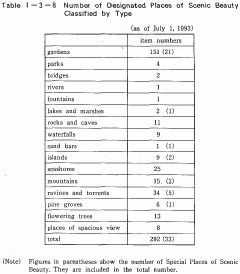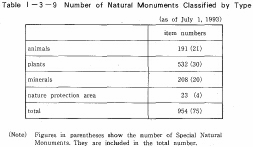| Home > Policy > White Paper, Notice, Announcement > White Paper > JAPANESE GOVERNMENT POLICIES IN EDUCATION, SCIENCE AND CULTURE 1993 > CHAPTER 3 �3 4 (1) | ||
Historic sites are those shell mounds, tombs, castle remains and so on, which are indispensable to understanding the history of Japan and which are highly valuable in terms of both quality and quantity when compared with other unearthed artifacts. As of July 1, 1993, 1,338 such monuments had been designated as Historic Sites.
Relics, as vestiges of the past that have their origins in politics, productive activities, life, religion and all of the other activities of the previous generations, are by their very nature naturally quite diverse in character. They can be considered under such classifications as: relics associated with life, funerary burial and rituals (shell mounds, tombs, dwelling sites and so on); relics associated with politics and military affairs, such as castle remains, sites of provincial and county governments; relics associated with religion, such as the ruins of shrines, temples and other structural vestiges; relics associated with education, such as feudal clan schools, private schools and other institutions j sites of medicinal herb gardens, charitable institutions and so on; relics broadly related to traffic, industry and civil engineering, such as parks, streets, ruins of barriers and sites of ceramic kilns; graves, epitaphs and so on ; old dwellings, gardens and relics with historical backgrounds; those relics associated with foreign countries or foreigners ; and so on. The number of designated historic sites classified by type and period are as shown in Table I-3-7. In 1992, Oita Prefecture's "Ankoku-ji Syuraku Iseki", known as the "Toro Site of the West", and five other historic sites were designated.

Places of scenic beauty can be roughly divided into two categories it hose mainly composed of natural elements such as mountains, ravines and seashores and those mainly consisting of artificial elements, such as gardens and parks. Both types of places have high artistic and scenic value and are indispensable to Japan's native climatic charm. Including both types, the total number of designated places of scenic beauty stood at 292 as of July l. 1993.The number of places of scenic beauty classified by type are shown in Table 1 3-8. In 1992,the "Heijokyu Sakyo Sanjo Nibokyuseki Teien" in Nara Prefecture was redesignated as a Special Place of Scenic Beauty.

Natural monuments are classified into animals, plants and minerals, and natural protection areas in which the combination of such monuments constitutes a high cultural value. They are all important natural monuments in the land of Japan. As of July l, 1993, 954 natural monuments had been designated. The number of monuments classified according to type is shown in Table I-3 9. The designation of natural monuments is granted to those which have been found worthy as the result of investigations conducted during the second half of the l960's on the state of Japanese vegetation and the state of Japanese precious fauna and flora. Designations were made in the natural monuments' order of importance. Newly discovered fossils and other minerals have also been designated.

| Back to Top | MEXT HOME |